The Power of Proximity Communication
How companies like Alaska Airlines, DHL, Henry Schein, and Moto Hospitality are scaling trust by empowering leaders to communicate where it matters most.

Proximity in action: DHL’s Smart Connect strategy
When DHL set out to connect their 600,000 global employees, including 300,000 frontline workers without regular access to digital channels, they didn’t just launch a new app.
They built a strategy around inclusion, relevance, and trust. With Smart Connect — DHL’s personalized employee app powered by Staffbase — they activated more than 5000 trained local editors. These on-the-ground communicators now publish content in more than 55 languages, making information meaningful where it matters most.
The result? A communication network that’s local, scalable, and human — and a blueprint for how proximity communication can turn internal comms into a pillar of employee experience.
DHL isn’t alone. Across industries, organizations are recognizing that proximity communication, led by local voices, has the power to rebuild trust, boost engagement, and drive change from the inside out.
Discover how DHL’s Smart Connect app is transforming internal communication for 600,000 employees worldwide.
1. The case for proximity
Trust isn’t what it used to be. In today’s workplaces, communication is harder, skepticism is higher, and employees are less open to change than ever before. As the pace of transformation accelerates — from AI to restructures to return-to-office mandates — leaders and communicators are struggling to break through. And when people stop listening, it’s not just an engagement issue. It’s a trust issue.
At Staffbase, we believe the answer isn’t louder communication. It’s closer communication.
Proximity communication means empowering the people employees trust most — their local leaders — with the tools, support, and confidence to show up and speak up. When done right, this approach builds credibility, strengthens culture, and makes strategy feel real. And the data backs it up. Staffbase customers who empower local leader voices see up to 55% more engagement.
 This white paper explores why proximity matters now, how leading organizations are making it work, and what it takes to close the trust gap — from channels and coaching to AI-powered nudges. Featuring real-world examples from brands like Alaska Airlines, DHL, Henry Schein, and Moto Hospitality, it shows how proximity isn’t just powerful in a time of change. It’s essential.
This white paper explores why proximity matters now, how leading organizations are making it work, and what it takes to close the trust gap — from channels and coaching to AI-powered nudges. Featuring real-world examples from brands like Alaska Airlines, DHL, Henry Schein, and Moto Hospitality, it shows how proximity isn’t just powerful in a time of change. It’s essential.
2. The proximity gap
Let’s be honest: internal communication has never been more complicated — or more critical. Change is constant. Channels are multiplying. Employees are overwhelmed. And despite more tools than ever before, many feel more disconnected from leadership than they did a decade ago.
This is the Proximity Gap: the distance between corporate messaging and employee reality. Organizations are more connected digitally than ever, yet employees feel increasingly distant from the people and strategies that shape their work.
The data paints a clear picture
 Enterprise change initiatives are up 400% in recent years, but only 38% of employees say they’re open to change.
Enterprise change initiatives are up 400% in recent years, but only 38% of employees say they’re open to change.
Employees want clarity. They want to hear from leaders. But not necessarily from headquarters. According to our 2025 Employee Communication Impact Study, 59% of all employees surveyed trust their immediate supervisor more than any other source of company information. Employees clearly want stronger communication from leaders, but when we look at the data, the gap just widens.
Just look at Moto Hospitality. With a lean internal comms team of three, they launched their Staffbase-powered app, Loop, with a clear strategy: build excitement, train site-based leaders, and make local communication part of daily life. The result? A 96% sign-up rate and a platform that colleagues now seek out for news, recognition, and connection. From day one, site leaders supported onboarding and introduced colleagues to the content — and over time, many became active contributors, celebrating wins, sharing updates, and helping their teams stay informed and engaged.
And yet, despite this kind of success, many organizations haven’t made the shift. While 91% of Staffbase customers give leaders permission to post on comms platforms, only 19% of those leaders actually do so.
 The opportunity is right in front of us. Proximity communication closes the gap — not by broadcasting louder, but by empowering the voices already closest to employees: team leads, managers, and local champions who know their context, speak their language, and show up where it counts.
The opportunity is right in front of us. Proximity communication closes the gap — not by broadcasting louder, but by empowering the voices already closest to employees: team leads, managers, and local champions who know their context, speak their language, and show up where it counts.
This isn’t just a shift in messaging — it’s a shift in mindset. It requires corporate communications teams to go beyond message sending and be messaging enablers. Proximity isn’t about reducing control. It’s about increasing trust. It’s how strategy becomes reality.
Proximity is how strategy becomes reality.
3. What proximity communication really means
When people hear “proximity,” they think physical distance. But in the world of internal communication, proximity isn’t about where you are. It’s about how close you feel. Proximity communication isn’t a geographic strategy — it’s a trust strategy.
It’s about relevance: communication that speaks to what matters locally.
It’s about resonance: messages that feel timely, human, and real.
It’s about relationships: hearing from people you know — and believe.
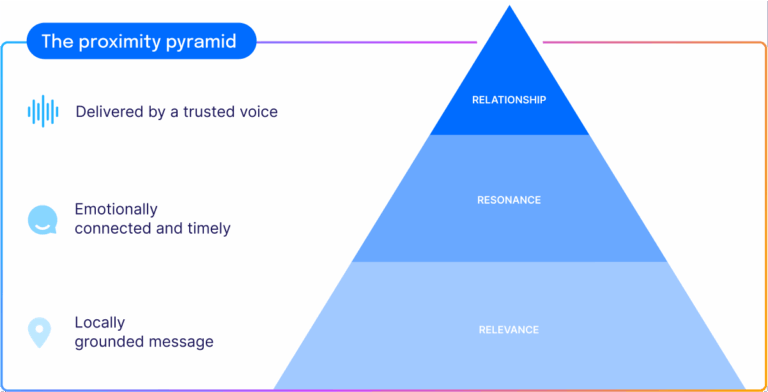 That understanding rarely lives at headquarters. It lives with local leaders — managers, site leads, team supervisors — the people closest to the employee experience. But for too long, these leaders have been seen as recipients of communication strategies. Proximity communication flips that model. It makes them messengers as well.
That understanding rarely lives at headquarters. It lives with local leaders — managers, site leads, team supervisors — the people closest to the employee experience. But for too long, these leaders have been seen as recipients of communication strategies. Proximity communication flips that model. It makes them messengers as well.
This shift matters, because today’s employees are navigating complexity, change, and uncertainty on the ground. Each function has a unique role to play. Executive leaders are essential for setting the vision, and corporate communications teams bring that vision to life at scale. But local leaders have a unique strength: they are the translators — making change meaningful, understandable, and relevant to their teams. They speak the language. They understand the culture. And when they communicate with intention, they can build trust in ways a global broadcast never will.
Putting principle into practice
Henry Schein puts this principle into practice by segmenting communication across geographies and business units. With local news channels in most countries where they operate, they empower leaders to shape messages that are both context-aware and culturally relevant — and they back them with editorial support to ensure those messages ring true. The result is communication that’s not just sent, but seen, understood, and trusted.
At VOICES 2025, Staffbase CEO Martin Böhringer put it simply: “Proximity communication is about trust, relevance, and relatability. Employees don’t need more updates. They need to hear from someone who understands their world.”
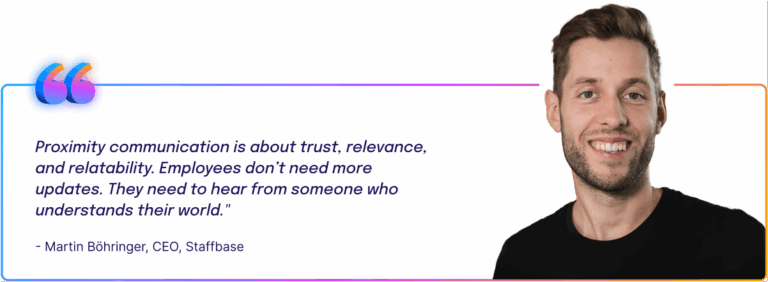 Martin’s message was clear:
Martin’s message was clear:
Trust doesn’t scale through hierarchy. It scales through humans.
That’s the power of proximity. It’s not about replacing central comms — it’s about amplifying it, localizing it, and making it real. It’s the missing layer between executive vision and frontline reality. And when it’s done right, it doesn’t just close the trust gap. It strengthens the whole communication ecosystem.
 4. What the data tells us (and what it doesn’t)
4. What the data tells us (and what it doesn’t)
Let’s look at the numbers.
The majority of companies are already set up to enable proximity communication. As previously stated, 91% of organizations on the Staffbase platform give leaders permission to publish content.
That’s the good news.
But here’s the reality check: only 57% of companies see those leaders actually posting. And even among the leaders who understand they have a role to play in communication, only 19% are actively contributing content.
And of that 19%, fewer than 4 in 10 are posting regularly.
That’s a striking drop-off — and a massive missed opportunity. Because the data also shows that when leaders do communicate, it works.
Alaska Airlines saw this firsthand. Through a well-coordinated launch that included training, targeting, and platform strategy, they equipped 145 people and functional leaders to share relevant updates — helping drive 99.5% adoption within a year and 75% weekly engagement platform-wide.
 At the company level, organizations where leaders are actively communicating see up to 55% higher weekly engagement than those where they aren’t.
At the company level, organizations where leaders are actively communicating see up to 55% higher weekly engagement than those where they aren’t.
And when you zoom in on individual behavior, consistency pays off: leaders who post at least once a month see 36% higher engagement than those who post just once a year.
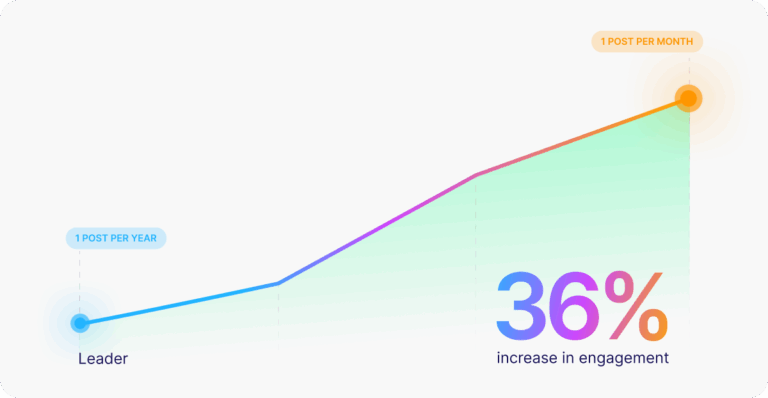 So, what’s really happening?
So, what’s really happening?
The platforms are in place. The permissions are granted. The expectations are often there, at least informally. But the loop isn’t closing. Somewhere between “can” and “do,” local leadership comms break down.
And it’s not for lack of value. These leaders are uniquely positioned to translate strategy into relevance, and to deliver it with credibility. They are the trust bridge. But without support, many aren’t stepping forward — or don’t feel confident doing so.
It’s not even for lack of trying. Corporate communications teams do try to bridge the gap. They coach, they cascade, they chase approvals. They build toolkits and templates and campaign briefings. But in the middle of a change rollout, with competing priorities and limited time, getting local leaders to pick up the mic — and actually use it — is tough. The intent is there. The impact often isn’t.
This isn’t a tooling problem. It’s a confidence problem. A clarity problem. A capability gap.
The takeaway? The opportunity is right in front of us — but it’s not self-activating. If we want local leaders to become communicators, we can’t just give them the keys. We need to give them a reason to drive.
That’s where strategy, enablement, and thoughtful nudging come in. And it’s where the next evolution of internal communication needs to focus — not just on what’s possible, but on what’s practical.
5. The long game: What happens when leaders stick with communication
Consistent communication builds confidence — and capability.
Our platform data shows that when leaders start communicating, they don’t just improve — they become more strategic, more intentional, and more impactful over time. Communication isn’t a fixed trait. It’s a skill. And like any skill, it improves with support, practice, and feedback.
 We’ve found that when organizations support leader comms, leaders begin to model the habits and behaviors of strong communicators:
We’ve found that when organizations support leader comms, leaders begin to model the habits and behaviors of strong communicators:
Leaders who stick with it get more strategic. After 18 months, their scheduled posts increase by 56% — a sign they’re thinking ahead and treating comms as part of their leadership rhythm.
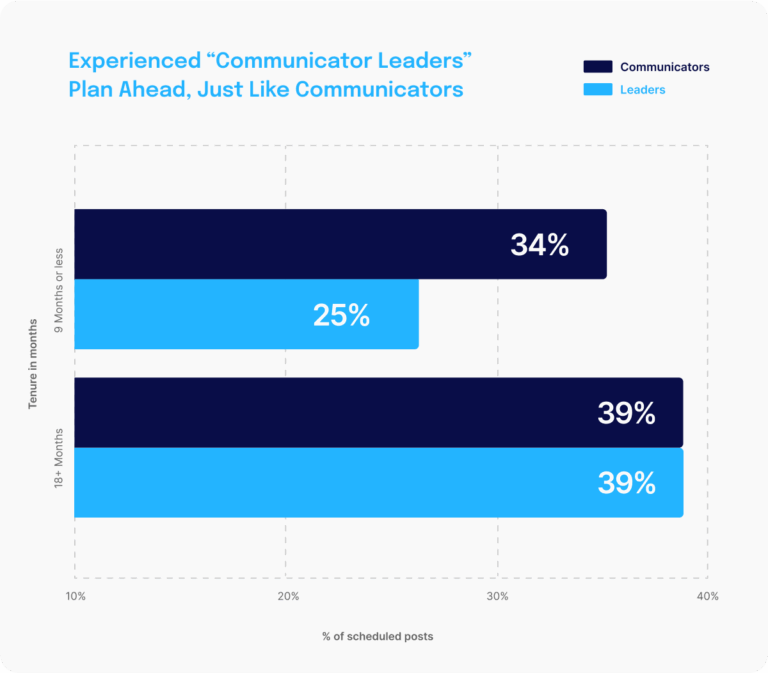 Increase in scheduled posts by leader communicators over 18 months
Increase in scheduled posts by leader communicators over 18 months
Experienced communicators post smarter. Drafts more than double as leaders reflect, revise, and tailor their messages.
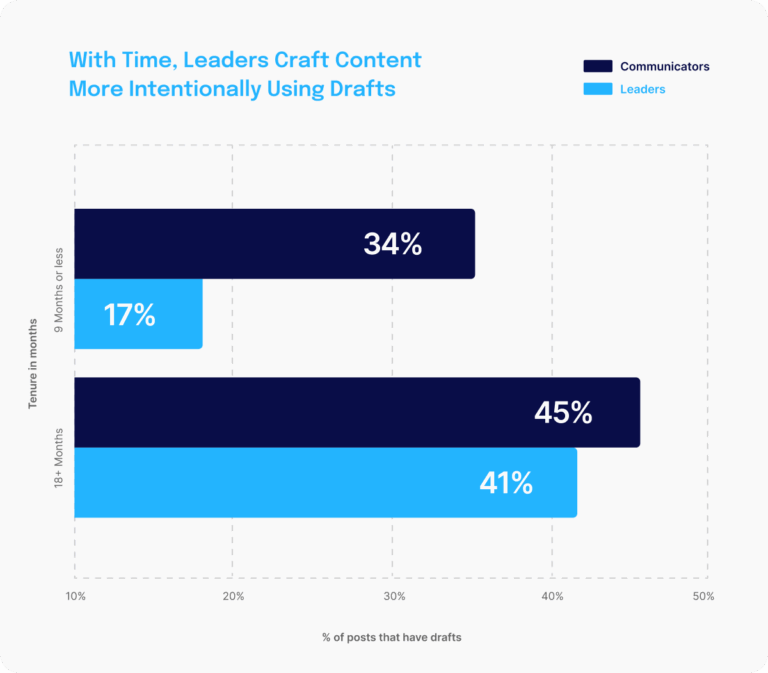 Ghostwriting declines. As leaders build confidence, they start using their own voice. They move away from templated messaging or comms drafted by others, and toward more authentic, personalized updates. That’s where trust lives.
Ghostwriting declines. As leaders build confidence, they start using their own voice. They move away from templated messaging or comms drafted by others, and toward more authentic, personalized updates. That’s where trust lives.
This is good news. It means that today’s hesitant leader can become tomorrow’s trusted voice. But it doesn’t happen by accident. It happens when organizations invest in the journey — through clear expectations, safe spaces to practice, supportive tools, and ongoing motivation.
And when we give leaders the tools and time to grow, the ripple effects are real: higher engagement, stronger culture, and more resilient teams — especially in times of change.
Because leadership communication isn’t just for the naturals. It’s for the willing.
6. How to activate communicator leaders
From spark to scale: Building a culture of leadership communication
The potential is there. The data proves it. But activating communicator leaders requires more than permission. It takes strategy, structure, and a system that grows with your people.
Here’s how to turn the spark of proximity communication into a sustainable source of trust and engagement — at scale.
 Set the role: Clarity before creativity
Set the role: Clarity before creativity
The first step is defining expectations. Leaders aren’t being asked to replace comms teams — they’re being invited to play a specific role in a shared system.
This starts with digital clarity. Where does Microsoft Teams fit? What lives in email? What belongs in Staffbase?
Operational comms stay in chat and task-based tools.
Strategic comms and culture-building live in Staffbase.
Leaders become the bridge between corporate vision and day-to-day reality.
But clarity alone isn’t enough. Leaders also need confidence and support — and that’s where corporate comms comes in. Not just as content creators, but as coaches and enablers. That means giving leaders:
A dedicated channel or Space they can own
Short, structured Briefings to guide messaging
Access to Staffbase Companion for tone and clarity help
Training sessions and templates that demystify the process
This shift reframes communication as leadership behavior — not just content delivery. And it positions the comms team as a critical partner in making it happen.
Create safe starting points
Many leaders hesitate because they don’t want to “mess anything up.” Staffbase Studio helps remove that fear with governance built in.
Give each leader their own channel or Space — a safe zone they can own without risking global comms.
Encourage video-first storytelling. Staffbase Shorts makes short-form video fast, mobile-friendly, and authentic. No camera crew required.
Layer in AI coaching. Staffbase Companion helps leaders improve tone, clarity, and impact — right inside the editor.
Think of it as the on-ramp. Low stakes. High support. Immediate visibility.
Connect online to onsite
Proximity isn’t just about the message — it’s about the moment. Help leaders amplify what’s already happening on the ground:
Local celebrations
Team wins
Milestones, retirements, onboarding shoutouts
When leaders reflect those moments online, they reinforce belonging and boost visibility across the organization. Culture becomes contagious.
Motivate with meaningful data
Better communication isn’t the end goal — better leadership is. And for many leaders, the missing link is understanding the impact they actually have.
That’s where data comes in. Not as a report card, but as a mirror that reflects influence. When leaders see that a short post led to an uptick in engagement, or their update sparked comments, recognition, or team pride — that’s when communication starts to feel like leadership, not a chore.
To build that habit, we need to show them why it matters. Not just what they sent — but what it sparked. Staffbase for Leaders Email Digest delivers:
A personalized Connect Score to show how many employees are engaging
Nudges and prompts based on performance benchmarks
Suggested replies and response alerts
Digestible insights they can act on — without needing to interpret a dashboard
Because when leaders see the connection between their voice and their team’s engagement, they don’t just become better communicators. They become more intentional leaders.
Start small, grow smart
Culture change starts with a few brave managers.
But it’s okay if it doesn’t start everywhere at once. It can be hard to get started — especially in organizations where communication feels top-down or where leaders haven’t been asked to use their voice before. That’s why a pilot-first approach works.
Start in one region or team.
Choose a business unit with engaged leadership and local energy.
Support them closely. Show what “good” looks like — and share their wins.
Use what you learn to refine, repeat, and expand.
Test, learn, and scale. That’s the proximity playbook.
Moto’s rollout started small: just a handful of site leaders, trained and supported with editable templates and drop-in coaching from the comms team. But it spread fast — not because it was top-down mandated, but because it made sense locally. That’s the power of starting smart.
This bottom-up momentum, combined with top-down endorsement, creates a powerful flywheel for adoption.
Staffbase Studio: Built for scale and structure
The best part? You don’t need to choose between flexibility and control. Staffbase Studio enables it all:
Spaces and channels for decentralized publishing
Guardrails for brand and message integrity
Campaign coordination and editorial calendars
Briefings to align leaders on tone, timing, and talking points
From governance to guidance, from spark to scale — this is what proximity communication looks like when it works.
7. Proximity in practice: How leading brands are scaling trust
Proximity communication isn’t a theory. It’s a proven strategy. You’ve seen it in action throughout this paper — from global logistics to regional hospitality to high-trust aviation. These organizations aren’t just talking about relevance and trust. They’ve built systems to scale it.
Here’s a recap of how they’ve made proximity communication work — and what your organization can take from their success.
Alaska Airlines
North America | 30,000+ employees across airline brands
Tiered messaging that empowers leaders at every level — from HQ to hangar.
Results:
145 leaders trained to post
99.5% adoption in 12 months
75% weekly engagement
What they did:
Structured communication across three tiers: enterprise, workgroup, and local
Created a Leader Portal to equip managers and area experts with timely messaging
Identified gaps via analytics and feedback to guide comms strategy
Supported teams with tech enablement and strategic consulting
 A strong framework and trust in local leaders helped Alaska Airlines turn proximity into a core operating principle.
A strong framework and trust in local leaders helped Alaska Airlines turn proximity into a core operating principle.
DHL Group
Global | 600,000 employees in 220 countries
A relevance-first strategy for activating local voices across a global network.
Results:
Connected 300,000 previously offline frontline workers
Reached 400K+ active users on the Smart Connect app
Trained 5000+ local editors
Published content in 80+ languages
71% of employees registered on Smart Connect
Smart Center reached 5 million+ monthly clicks on use cases
96% of office employees now familiar with the platform
What they did:
Launched Smart Connect, a mobile-first employee app that also functions as the front door to the intranet
Enabled personal device access to reach non-desk and logistics employees
Created localized Spaces to personalize content by business unit, region, country, or location.
Delivered a global enablement strategy built on:
Smart Campaign — onboarding and awareness
Smart Curriculum — live and e-learning formats for training
Smart Center — 600+ use cases, localized into 20+ languages
Smart Communities — forums and peer support for 500+ global champions
Distributed ownership between global and local comms teams to scale relevance
 By enabling proximity at scale, DHL turned internal comms into a strategic, measurable pillar of employee experience — built on trust, reach, and relevance.
By enabling proximity at scale, DHL turned internal comms into a strategic, measurable pillar of employee experience — built on trust, reach, and relevance.
Henry Schein
Global | Approximately 25,000 employees across 33 countries and territories
A segmented, support-driven strategy that empowers local leaders to own their voice.
Results:
Local news channels active in most operating countries
Engagement and reach improved through tailored content streams
Growing demand across the company to create localized channels
What they did:
Used Staffbase to segment content by geography and business unit
Offered support in shaping authentic leadership messages
Helped local teams build their own content hubs — driving adoption from the ground up
 By making space for local voices and backing them with strategy, Henry Schein turned communication into shared ownership.
By making space for local voices and backing them with strategy, Henry Schein turned communication into shared ownership.
Moto Hospitality
UK | 6200 employees across 59 sites
A small team, a smart strategy, and a self-sustaining culture of site-level comms.
Results:
96% colleague sign-up rate
Loop became a daily habit for local storytelling
Loop Champions and “Top Fans” recognize and reward engagement
What they did:
Hosted regular drop-in sessions and created “How To Loop” and “Rocket Fuel for Sites” guides
Provided editable templates for local leader comms
Built a community for Loop Champions with tasks and challenges to drive participation
 Loop has become more than a channel — it’s a daily destination for connection. Proof that you don’t need a big team to make a big impact, just the right strategy.
Loop has become more than a channel — it’s a daily destination for connection. Proof that you don’t need a big team to make a big impact, just the right strategy.
Across industries, one thing is clear: when proximity communication is intentional, scalable, and supported, trust doesn’t just grow. It drives results.
8. Your next step: Scaling proximity with confidence
 Proximity isn’t a trend. It’s a shift — a new way of thinking about internal communication that prioritizes relevance, trust, and connection. And it’s already reshaping how leading organizations engage their people.
Proximity isn’t a trend. It’s a shift — a new way of thinking about internal communication that prioritizes relevance, trust, and connection. And it’s already reshaping how leading organizations engage their people.
Across industries, the message is clear: employees want to hear from the people they know. They want communication that feels personal, timely, and grounded in their day-to-day. The organizations succeeding today aren’t those shouting the loudest from HQ — they’re the ones empowering leaders closest to the work to share what matters most.
If you’re ready to close the gap between strategy and reality, start by asking: Are you proximity ready?
 With Staffbase for Leaders — a bundle that includes Briefings, Shorts, and the Email Digest — you have everything you need to activate the most trusted voices in your organization.
With Staffbase for Leaders — a bundle that includes Briefings, Shorts, and the Email Digest — you have everything you need to activate the most trusted voices in your organization.
You don’t need a whole new playbook. You need a smarter way to scale what works.
Proximity starts small — but it scales big. And the time to start is now.









